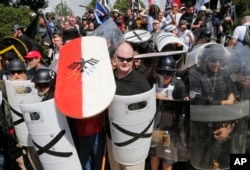While American white supremacists and ultra-nationalists have been appearing in public and the news more often recently, the heads of the U.S. military have made clear such individuals have no place in the ranks.
The commanders of the U.S. Army, Air Force, Navy and Marine Corps last week issued strong statements condemning intolerance and racism after protests in the city of Charlottesville, Virginia turned deadly. Organizers and participants in the original demonstration espoused racist, white nationalist positions.
That’s a crucial message for those in uniform, say some military experts and veterans.
“It was important, I think, for the service chiefs to get on record with what had happened and to show that what was being represented in Charlottesville as people standing up for their culture really had no place in our armed forces. It wasn’t our [military] culture,” said Peter Mansoor, a retired U.S. Army colonel and professor of military history at Ohio State University.
The message was clear, said Steven Leonard, a retired U.S. Army colonel now teaching at the University of Kansas School of Business. “If you can’t live by the values of our institutions, then you don’t have a place in the ranks.” Leonard also runs the popular Doctrine Man micro-blog and social media platform, which discusses military and veterans' issues.
The Department of Defense bans actively advocating supremacist, extremist or criminal gang causes. Doing so can result in dismissal from military service.
While the military is one of the most socially integrated communities in the United States, it has had a problem with extremists in the ranks. Some current leaders of racist organizations have served, and veterans have committed several hate and terror crimes in recent years.
The military has acknowledged it has a problem, most notably after Army veteran Timothy McVeigh blew up a federal office building in Oklahoma City, Oklahoma in 1995, killing 168 people. The Department of Defense went on a campaign to oust militants.
And it made progress, according to the Southern Poverty Law Center, which tracks U.S. hate groups; but, in less than a decade, that ground was lost because the military relaxed recruiting standards to meet demand as the U.S. fought wars in Afghanistan and Pakistan, the center said in reports issued in 2006 and 2012.
“The military is a reflection of American society,” Mansoor said – which means it has members of all backgrounds and beliefs. “You get this sliver that comes in; they may have grown up in a gang culture, or white nationalist culture.”
Some criminal gangs and white nationalist groups in the U.S. encourage adherents to join the military, particularly Army and Marine Corps combat, according to Southern Poverty Law Center studies. Some nationalist groups advocate a “race war” against African Americans, Jews and other minorities, and they want members with weapons and tactical experience.
“They’ve been doing that for years,” Leonard said, as have criminal gangs. “Where else can you get the skills?”
But that creates a challenge. A service member who holds allegiance to a hate group or gang is likely to stay quiet, and remain in place.
“If they don’t pop up, what can you do?” Leonard said.
While DOD training emphasizes tolerance, Mansoor notes that it’s not possible to “train away” unwanted beliefs. “You sort of have to live it day to day and model the values and drive it home at every opportunity.”
And, it’s essential to do so, said Mansoor, who served as a brigade commander in Iraq in 2003. “If you have division in the ranks based on the color of one’s skin or their religious creed or their gender, it’s like a cancer that grows and causes division and eventually will cause a reduction in the combat effectiveness of the unit.”
That is why commanders train troops from the very start that they are all one force – to do otherwise weakens it, former commanders said.
While there might be white supremacists in the ranks, overall, the military has become one of the most ethnically mixed segments of the country since it was integrated nearly 70 years ago. Service members of all backgrounds live and work in tight quarters on ships and in barracks, while housing and schools for their families reflect the full range of the nation’s population.
“We’re supposed to be a better example of what it is to be a good citizen,” said Margaret Witt, a retired Air Force major who was dismissed because of her sexual orientation. Now a physical therapist for the Veterans Administration in Portland, Oregon, Witt’s successful lawsuit over her dismissal paved the way for the DOD decision to allow gays and lesbians to serve in the military.
“The military really has made a tremendous effort to lead the way” on tolerance, including on the acceptance of gays and lesbians, she said, although it takes time to change attitudes in such a large organization.
The military does adapt to social change, Leonard said, because the measure that matters is how well a service member performs.
“Can you do your job and will you do your job when the bullets start to fly?” he said. Because if you can’t, “you start to put people’s lives at risk.”










